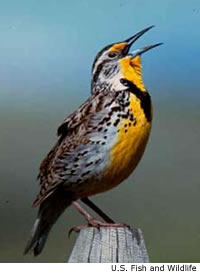Western Meadowlark

The western meadowlark is the state bird. This charming bird has all over brown and black coloring except for its bright yellow chest that has a black V on it. The song of the western meadowlark is a series of flute-like gurgling notes that go down the scale. The western meadowlark lives in meadows, plains, prairies and other open grasslands. This bird usually eats insects, although it will, on occasion, eat seeds.
The female finds a depression in the ground and builds a nest by digging in the dirt with her bill. She lines the depression with soft grass and forms a roof by pulling grass and plants over the depression. She then weaves in grass to make a waterproof dome, leaving enough space for an opening. The male protects the nest by noisily chasing intruders away.
Prairie Chickens
 Kansas has the largest flock of prairie chickens remaining on the North American continent. Prairie chickens were once abundant, but have become extremely rare in most places due to habitat loss. One of the most noteworthy facts about this species is its mating ritual called 'booming' - the males inflate the air sacs located on the side of their necks and snap their tails to attract females.
Kansas has the largest flock of prairie chickens remaining on the North American continent. Prairie chickens were once abundant, but have become extremely rare in most places due to habitat loss. One of the most noteworthy facts about this species is its mating ritual called 'booming' - the males inflate the air sacs located on the side of their necks and snap their tails to attract females.Eskimo Curlew

The Eskimo curlew is another Kansas bird, which is a New World bird. Members of this species bred on the tundra of western arctic Canada and Alaska. One of the most important food sources was the Rocky Mountain Locust Melanoplus spretus. This species extinction circa 1902 may be a partial cause of the Eskimo Curlew's decline. Habitat destruction at wintering grounds in the Pampas is also implicated as preventing any recovery.
Whooping Crane

The whooping crane is an endangered species named after its whooping call. It is one of only two crane species found in North America. These majestic birds forage while walking in shallow water or in fields, and they are omnivorous. Click here to hear the sound of a whooping crane.

No comments:
Post a Comment